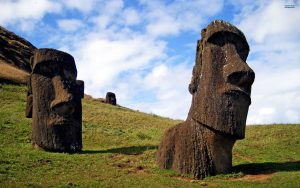By Sal Maccarone
Even from the most isolated place on earth, humanity has managed to express itself artistically for the ages. Shrouded in mystery, Easter Island truly lies in the middle of nowhere. Among other things, this tiny island in the Pacific Ocean has become famous for its one thousand, or so surviving monolithic sculptures. Now, a UNESCO World Heritage Site, the island is known by the Polynesian people as Rapa Nui, because of the Rapa Nui people who carved the statues some 600 – 1200 years ago.
Rediscovered on Easter Sunday 1722 by European explorer Jacob Roggenveen, Easter Island has fascinated historians, and archeologists ever since. How the original Rapa Nui people arrived on this pin point of an island is still something of a mystery. Regardless of how the inhabitants arrived, these artistically inclined people evolved into sculptors on a grand scale. Their sculptures are named Moai which means “statue” in Polynesian. It is believed that the Moai were built to honor important Rapa Nui ancestors.
All one thousand of the 7 – 34 foot high, many thousand pound humanoid looking sculptures on the island are carved of volcanic rock. A few of the Moai are still totally intact, and those statues are comprised of three basic parts: a main body of black volcanic rock, a topknot, (or hat), made of red volcanic rock, and then sea shell with corral eyes.
For a long while the many Moai heads that are sticking out of the ground were thought to be very curious. Then it was recently discovered that the heads also have torsos buried thirty feet down. A couple of these sculptures have been excavated by a team from UCLA to revel the underlying bodies.
Many of the Moai are situated in groups on long pedestals that are elaborate in themselves. Some of these groups are located on beaches always facing inland. Obviously, the Moai had great cultural significance to the Rapa Nui people that built them, but it is still not completely understood why the statues all face inland, and not toward the sea.
The Moai were carved in volcanic bays of rock, and then detached; all with the most primitive of tools. The sculptures were then moved down hill and stood upright so that the backs could be finished. Not an easy task! The process of finishing a single Moai took decades. About 350 unfinished Moai have been discovered on the island; the largest being more than 60 feet tall.
The finished Moai were ultimately moved along a network of roads to places all over the island. There has been a lot of speculation regarding how the statues were actually moved. At 34 feet high and close to 100 tons, these sculptures would be hard to move with today’s technology. For many years, it was thought that perhaps they were rolled lying on their backs using palm tree trunks. Beginning in the 1950’s there have been a multitude of experiments moving replicas via sleds, palm trunks, etc. More recently there has been a successful moving experiment that involved teams with ropes rocking an upright Moai replica down the road. This upright theory makes a lot of sense, after all, the legends of the island clearly states that: “The Moai walked from the quarries to their final resting spots.”
Sal Maccarone









